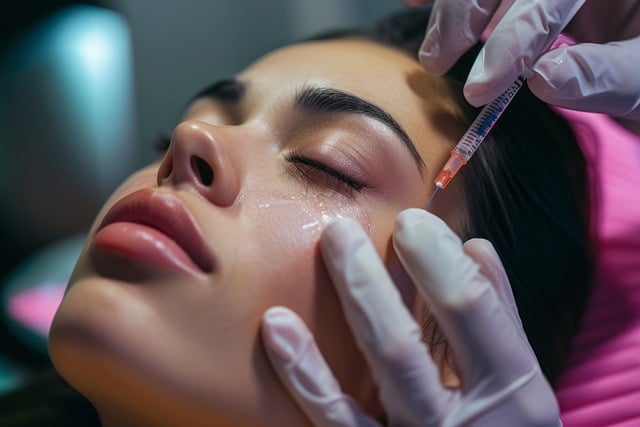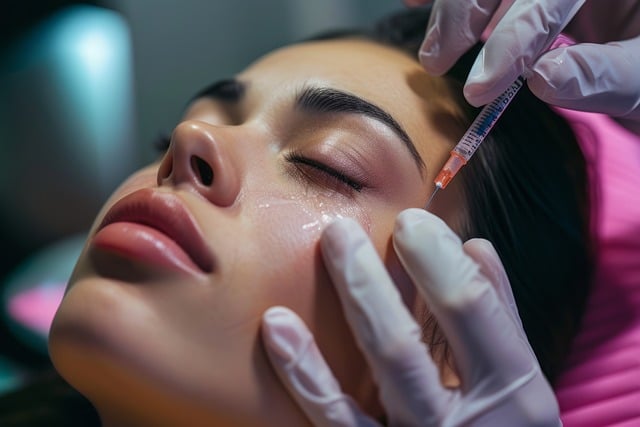Botox vs Dermal Fillers: Key Differences and Considerations for Youthful Complexion
This text compares Botox and dermal fillers, two leading anti-aging treatments. Botox, a neurotoxin, temporarily paralyzes muscles to reduce dynamic lines around the eyes, forehead, and mouth (3-6 months effect). Dermal fillers, injectable substances like hyaluronic acid or collagen, instantly add volume, smoothing wrinkles, and enhancing facial contours (lasting from months to years). The choice between them depends on personal preferences, skin goals, and targeted areas. Both treatments require consultation with a healthcare provider, who will assess needs, recommend suitable products, and discuss potential side effects. Regular maintenance is essential for optimal results.
“Unveil the secrets to achieving and maintaining youthful skin with our comprehensive guide on Botox and dermal fillers. These non-invasive treatments have revolutionised skincare, offering a path towards a smoother, more rejuvenated complexion. From understanding the science behind Botox’s ability to relax muscles and its diverse benefits to exploring dermal fillers’ role in adding volume and definition, this article delves into the key differences and similarities between these popular procedures. Learn how to make an informed decision, understand the application process, and prepare for potential side effects to unlock your skin’s transformative potential.”
Understanding Botox and Dermal Fillers: Unlocking Their Potential for Skincare

Botox and dermal fillers are two popular treatments in the skincare industry, each offering unique benefits for achieving a youthful complexion. Understanding their mechanisms and potential is key to unlocking a more radiant and healthy-looking skin.
Botox, or botulinum toxin, is a neurotoxin that temporarily paralyzes muscles, reducing the appearance of fine lines and wrinkles. It’s particularly effective in treating dynamic lines around the eyes, forehead, and mouth. On the other hand, dermal fillers are injectable substances that add volume to the skin, smoothing out wrinkles and enhancing facial contours. They can be made from various materials like hyaluronic acid, collagen, or synthetic compounds, each with its own advantages. While Botox focuses on relaxing muscles, dermal fillers provide immediate volume restoration, making them suitable for different skincare concerns. The choice between the two depends on individual preferences and specific skin goals, highlighting their complementary roles in modern skincare routines.
The Science Behind Botox: How It Works and Its Benefits

Botox, a protein derived from bacteria, has revolutionized skincare with its ability to temporarily paralyze muscle movement. When injected into specific areas, it smoothens wrinkles by preventing the contractions that cause them. This non-invasive procedure offers a significant advantage over dermal fillers, as it focuses on treating dynamic lines rather than filling static ones.
Compared to dermal fillers that add volume and enhance skin texture, Botox provides a subtle yet effective lifting effect. It’s particularly beneficial for areas like the forehead, crow’s feet around the eyes, and frown lines between the brows. The treatment’s quick procedure time and minimal downtime make it a preferred choice for those seeking to delay the signs of aging without drastic measures.
Dermal Fillers: A Comprehensive Look at Their Role in Skin Rejuvenation

Dermal fillers and Botox are both popular treatments in the quest for youthful skin, but they work in distinct ways. While Botox is a neurotoxin that temporarily paralyzes muscles to reduce dynamic wrinkles, dermal fillers are substances injected into the skin to enhance its volume and elasticity. These fillers can be made from hyaluronic acid, collagen, or synthetic materials, plumping up wrinkles and enhancing facial contours.
When considering Botox vs dermal fillers, it’s crucial to understand their strengths and limitations. Fillers offer immediate results and can last for several months to years, depending on the type used. They’re ideal for addressing static wrinkles and providing a more defined jawline or fuller cheeks. In contrast, Botox takes a few days to take effect but offers longer-lasting results, typically lasting 3-6 months, focusing on smoothing dynamic lines caused by facial expressions. The choice between them depends on individual goals, skin type, and the specific areas targeted for rejuvenation.
Comparing Botox and Dermal Fillers: Key Differences and Similarities

When considering non-invasive skin treatments, understanding the nuances between Botox vs Dermal Fillers is essential for informed decision-making. Both procedures aim to enhance facial aesthetics, but they target different aspects of skin aging. Botox primarily focuses on relaxing muscle activity, effectively reducing dynamic wrinkles such as frown lines and crow’s feet. This results in a smoother, more youthful appearance by preventing the contraction of specific muscles responsible for these telltale lines.
On the other hand, dermal fillers are designed to add volume and shape to the skin by smoothing out static wrinkles and enhancing facial contours. They work by injecting hyaluronic acid or other substances beneath the skin’s surface to fill in depressions and add definition to the face. While Botox addresses the cause of wrinkles by inhibiting muscle movement, dermal fillers provide immediate results by restoring the skin’s natural plumpness. Choosing between them depends on individual needs; some people may opt for both treatments simultaneously, combining the benefits of muscle relaxation and volume enhancement for a comprehensive anti-aging approach.
Choosing the Right Treatment: Factors to Consider Before Your Procedure

When considering skincare treatments, it’s crucial to understand the differences between Botox and dermal fillers—two popular options for achieving a youthful complexion. Both procedures offer anti-aging benefits, but they work in distinct ways. Botox is a neurotoxin that relaxes muscles, preventing dynamic wrinkles from forming. It’s ideal for fine lines and frown lines around the eyes, forehead, and mouth. On the other hand, dermal fillers enhance volume loss by injecting a substance beneath the skin to lift and sculpt facial contours. These are effective for deep wrinkles, hollow cheeks, or lost jawline definition.
Several factors should guide your choice between Botox vs. dermal fillers. Consider your specific concern—whether it’s muscle relaxation for fine lines or volume restoration for deeper wrinkles. Skin type and elasticity also play a role; Botox might be more suitable for those with thinner skin, while dermal fillers can provide better results for individuals with more robust skin. Cost, recovery time, and the desired longevity of results should also influence your decision. Consulting a dermatologist will help you make an informed choice tailored to your unique needs.
The Application Process: What to Expect During Your Botox or Filler Session

When considering Botox or dermal fillers for youthful skin care, it’s crucial to understand what to expect during your treatment session. The application process varies slightly depending on whether you’re opting for Botox or dermal fillers. For Botox, a healthcare professional will use fine needles to inject the solution into specific muscle groups, targeting wrinkles and lines. This procedure is typically quick, taking around 15-30 minutes, and is usually painless due to topical anesthetics applied before the injection. The number of injections and the amount of product used depend on your specific needs and the areas being treated.
On the other hand, dermal fillers involve the injection of a gel-like substance beneath the skin’s surface to add volume and reduce the appearance of wrinkles or scars. Unlike Botox, which primarily works by relaxing muscles, fillers immediately enhance the skin’s contour. The procedure is usually faster but may cause mild discomfort. Your provider will assess your skin and recommend the suitable filler type, injection sites, and quantity. It’s essential to discuss expectations and potential side effects openly with your healthcare professional before the treatment.
Potential Side Effects and Risks: Being Informed About Post-Treatment Care

Botox and dermal fillers are popular non-surgical cosmetic procedures, but understanding potential side effects is crucial before treatment. While generally safe when administered by a qualified professional, both treatments carry risks. With Botox, temporary muscle weakness or paralysis at the injection site is possible, affecting facial expressions. This can include drooping eyelids, frown lines deepening, or a changed appearance in facial symmetry.
Dermal fillers might cause redness, swelling, bruising, or discomfort at the injection sites. In rare cases, severe reactions like an allergic response or infections may occur. Proper post-treatment care is essential to mitigate these risks and ensure optimal results. This includes following the dermatologist’s instructions for managing side effects, avoiding strenuous activities, and maintaining a clean, sterile environment around the treated areas.
Long-term Results and Maintenance: Ensuring Lasting Youthful Skin

Botox and dermal fillers are both popular treatments for achieving a youthful complexion, but they offer distinct approaches to skin care. While Botox excels in preventing wrinkles by paralyzing muscles, dermal fillers enhance volume and contouring, plumping up sunken areas. For long-term results, many individuals opt for a combination of these treatments.
Maintaining youthful skin requires ongoing care. Regular touch-ups with Botox every 3-6 months can prevent the return of dynamic lines, while dermal filler injections may need to be repeated every 6-12 months depending on the product and individual metabolism. Consistent skincare routines featuring sunscreen, hydration, and retinoids are crucial complements to these treatments, ensuring lasting results well beyond each injection.
